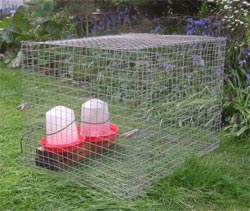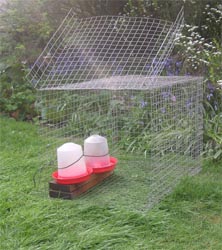How to make a broody coop to stop your chickens and bantams being broody (takes 1 hour to make)
Posted by Fiona Nevile in Chickens | 130 comments “Two of my hens are broody.” Bunty was exasperated.
“Two of my hens are broody.” Bunty was exasperated.
“We’ve got a broody one too.”
This was our first summer of keeping bantams (a small friendly breed of chicken).
Bunty continued, “I wish I hadn’t suggested Bantams. I’ve discovered that they go broody at the drop of a hat.”
Years ago Bunty had kept chickens commercially. Those were a type of chicken bred for laying that rarely go broody.
She thought that she had the answer to our dilemna.
“We need anti broody coops. You’re good at making things. Why don’t you make a couple?”
My heart sank. I thought that they would take hours to make, imagining a sort of dog kennel with a wide gauge wire mesh floor.
To stop a hen being broody you need to stop her from settling comfortably. The trick is to construct a cage with a floor made of large wire mesh ( with at least 1 inches squares). Set the cage on bricks so that the floor is suspended, keeping the bricks to the outside edges so that she can’t sit on them. Provide a small drinking fountain and feeder within the cage and pop her in. She won’t be able to settle on the wire mesh floor and within a few days will get over her broodiness.
I went to bed early and woke at four. In the still cold light I realised that the entire cage could be made of wire mesh. I went to the garden centre after breakfast and bought three sheets of wire mesh measuring 90cm x 60cm. The cage is 60 cm long and 43 cm high and 43 cm wide This allows for an overlap at the joins.
Our broody coop is simple to make. Lay the wire on a flat surface, and bend 2 cm of wire mesh to a 90 degree angle along a 60 cm side. Then lift the opposite end and press it into the angled flap. Press firmly on the bulgy end and fold flat to make a clean angle and pull the ends apart. You now have the floor and one side. Repeat the operation for the roof and the other side.The flap may seem a bit fiddly but it makes the cage much more rigid and stable.
Now attach the the two halves together to make the body of the cage. I tied the two together with twists of wire at 5cm intervals. The front and back of the cage are made from the remaining sheet. Hold the sheet against the opening at the back and cut to fit using wire clippers. The back was attached using wire twists. The front is hinged at the top with sides that bend back a bit over the sides of the cage.
Having a hinge at the top makes it easier to put the chicken in the cage. If you put her in headfirst you can quickly drop the door down and secure it with pegs before she has turned around. We used clothes pegs but small bulldog clips would be good for a larger chicken.

The broody coop in the photo is the mark one version. I made Bunty a Rolls Royce (mark two) cage out of plastic coated wire. Definitely worth the extra investment as it’s stronger and more durable. Carol (our Maran) has never been broody. If she was, I’d make her a bigger cage (the hen needs to be able to stand up). And it would have to be stronger than the mark one cage as she is a much larger bird than the bantams.
Our broody coop sits in the Day Centre. Bunty had hers in the run with a bit of wood as a roof.
It took me a while to realise when the perfect moment of release should take place. The chicken in the broody coop will ask to be released immediately. But bide your time. Her comb will gradually change from pink to red. When it is red she can get out of jail. If you release her while her comb is still pink she will nip back to the nesting box and you will have to start the process all over again.
If you have a broody chicken and you want her to sit on fertilised eggs put a floor on the bottom of the broody coop, fold the door over the roof and you have a quiet area in which she can sit for twenty one days, with easy access to food and water. She needs to be able to move away from the nest so don’t lock her in. Ideally, place the cage somewhere that is protected from the elements. Or construct a simple roof like Bunty did (a bit of plywood slightly bigger than the cage). It’s not a good idea to let a broody hen stay in the nesting box as it puts the other hens off laying eggs.
Leave a reply





Hi Pete
Our broody coop is in the run, in an open building with a roof, as it wouldn’t fit in the hen house. It seems to work well. The hens can see the prisoner and vice versa.
I’d have a go with the broody coop in the hen house.
It’d be interesting to here how you get on.
hi one of my hens has started to stay on her nest , she also has been pulling the other hens eggs in for her to sit on , i havent noticed any change in her comb but once i move her to get the eggs she streches her legs has a feed and drink and goes back to her nest about 30 mins later. i can put her in to solutry in the hen house as its big enough to do so and can keep her of the floor with mesh , will this be enough or does she need to be outside and well away from the other hens ??
Hello Mary
It’s difficult to say as your hens were broody for so long. The red combs are a good sign.
They will start laying soon. It’s hard but you just have to be patient.
If you had left them to be broody you probably wouldn’t have seen any eggs from them until next year! And they probably would have disturbed the laying cycles of your other hens.
Thank you for all the advice. I just wish I had read it sooner. Two of my six hens have been broody for 8 to 10 weeks. I tried everything (in my ignorance) except the broody coop. They have been out and about now for 1 week and the comb is bright red but no sign of an egg. How long should I expect this to go on for? Your advice would be so welcome.
From Mary
Hi Amanda
Our hen are in a big run and are not free range so I have no experience of them eating plants n my garden. Loads of plants are poisonous and I have no idea if they would eat these or not.
However, I have visited many houses where the chickens are free range in a normal garden and are happy and healthy.
This is something that would be worth investigating further.
I have 3 hens (20wks)& 2 silkies (24wks)no eggs yet, I know its early yet, waiting patiently! They are in a sectioned off part of my garden but would like them to roam freely my worry is as I have a lot of plants and flowers when I have let them roam they eat various plants and end up with runny pooh, they presumably eat anything & won’t know what not to eat. Is it ok to let them free or should I wait till most have died down (the plants) they’re particularly fond of my hosta. Can they get really sick from eating garden plants. They’re fed layers pellets, mixed corn, greens & other veg as their normal diet as well as the bugs they find in their own garden area.
Hi Lu
Hope that everything goes well with the hatching. I’d love to hear how you get on!
Thanks for your help one seems to be pipping so fingers crossed. They are Lavendar Araucana eggs bought at great expense on ebay, not sure I will be going down the ebay route again!
Hi Lu
What kind of eggs is she sitting on? Different eggs take different times to hatch. If they are hen or bantam eggs, quite often they just need a few more days.
Have you candled the eggs?
Personally, I wouldn’t put a hen in the anti broody coup if she had sat on a nest for days. Give her a break.
I’ve heard that dunking chicken bums in cold water doesn’t stop them being broody.
Give her a bit more time to hatch the eggs. Make plans after a week of waiting past the egg hatching date. Then remove the eggs, examine them and then start asking questions.
BTW if three eggs cracked they probably had very thin shells, nothing to do with your hen.
I have a broody sat on some eggs I bought on ebay, she started with 5 and managed to break 3 of them (don’t know how as she has plenty of bedding), anyway she has been on the last 2 for 23 days and they are showing no signs of hatching. Will she stop being broody now even though she hasn’t hatched any chicks or do I need a brookdy coop. Also read on another website that plunging the chicks bum in cold water can stop them going broody, any comments?